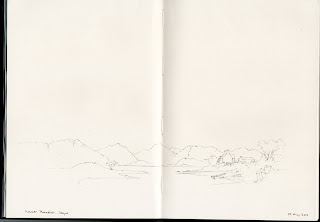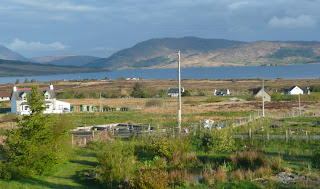David and I have just returned home from a trip to Skye. We stayed with Rosemary Hale in Aird of Sleat at her lovely coft house for a few days and for me it was sketching heaven with traditional buildings in every direction against a backdrop of mountains and islands.
 Half Seventeen in Aird of Sleat where we stayed with Rosemary |
There were so many scenes to sketch that I had to work very quickly. In these circumstances I often create outline sketches in the field so that I can capture more compositions, and add watercolour washes to these in the evenings. That way I have plenty of material to work from when I return home and return with a feeling of having done justice to the plethora of subjects.
 Lower Breakish, Sketch done out of doors in about 10 minutes |
 Lower Breakish, Watercolour washes added the same evening |
By adding the watercolour washes to the sketch the same evening, the colours are still fresh in my mind. Sometimes I make colour notes on the pencil sketch to remind me. Working this way I can produce 5 or 6 sketches a day instead of just one. This sketch was done on a walk along the shore at Lower Breakish.
Towards the end of our stay on Skye we spent a couple of nights with Helen Stephensen at her superb Bed and Breakfast, Sealladh Alainn, in Lower Breakish. The views from the breakfast table across the Loch were stunning with subjects to draw and paint in every direction.
 View from the breakfast table at Sealladh Alainn |




